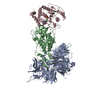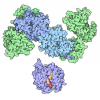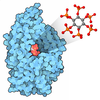+ データを開く
データを開く
- 基本情報
基本情報
| 登録情報 | データベース: PDB / ID: 8uh6 | ||||||
|---|---|---|---|---|---|---|---|
| タイトル | Degrader-induced complex between PTPN2 and CRBN-DDB1 | ||||||
 要素 要素 |
| ||||||
 キーワード キーワード | HYDROLASE | ||||||
| 機能・相同性 |  機能・相同性情報 機能・相同性情報negative regulation of interleukin-2-mediated signaling pathway / negative regulation of interleukin-4-mediated signaling pathway / negative regulation of positive thymic T cell selection / positive regulation of PERK-mediated unfolded protein response / negative regulation of platelet-derived growth factor receptor-beta signaling pathway / negative regulation of macrophage colony-stimulating factor signaling pathway / negative regulation of interleukin-6-mediated signaling pathway / regulation of type II interferon-mediated signaling pathway / negative regulation of macrophage differentiation / negative regulation of chemotaxis ...negative regulation of interleukin-2-mediated signaling pathway / negative regulation of interleukin-4-mediated signaling pathway / negative regulation of positive thymic T cell selection / positive regulation of PERK-mediated unfolded protein response / negative regulation of platelet-derived growth factor receptor-beta signaling pathway / negative regulation of macrophage colony-stimulating factor signaling pathway / negative regulation of interleukin-6-mediated signaling pathway / regulation of type II interferon-mediated signaling pathway / negative regulation of macrophage differentiation / negative regulation of chemotaxis / negative regulation of tyrosine phosphorylation of STAT protein / negative regulation of monoatomic ion transmembrane transport / positive regulation of endoplasmic reticulum stress-induced intrinsic apoptotic signaling pathway / negative regulation of receptor signaling pathway via JAK-STAT / positive regulation by virus of viral protein levels in host cell / epigenetic programming in the zygotic pronuclei / spindle assembly involved in female meiosis / Cul4-RING E3 ubiquitin ligase complex / UV-damage excision repair / Interleukin-37 signaling / syntaxin binding / biological process involved in interaction with symbiont / regulation of mitotic cell cycle phase transition / WD40-repeat domain binding / Cul4A-RING E3 ubiquitin ligase complex / negative regulation of type I interferon-mediated signaling pathway / negative regulation of T cell receptor signaling pathway / Cul4B-RING E3 ubiquitin ligase complex / STAT family protein binding / regulation of hepatocyte growth factor receptor signaling pathway / ubiquitin ligase complex scaffold activity / insulin receptor recycling / negative regulation of epidermal growth factor receptor signaling pathway / negative regulation of type II interferon-mediated signaling pathway / negative regulation of reproductive process / negative regulation of developmental process / locomotory exploration behavior / endoplasmic reticulum-Golgi intermediate compartment / viral release from host cell / cullin family protein binding / non-membrane spanning protein tyrosine phosphatase activity / negative regulation of lipid storage / peptidyl-tyrosine dephosphorylation / T cell differentiation / positive regulation of Wnt signaling pathway / negative regulation of tumor necrosis factor-mediated signaling pathway / ectopic germ cell programmed cell death / negative regulation of protein-containing complex assembly / proteasomal protein catabolic process / positive regulation of viral genome replication / Regulation of IFNG signaling / negative regulation of insulin receptor signaling pathway / positive regulation of gluconeogenesis / protein-tyrosine-phosphatase / B cell differentiation / erythrocyte differentiation / protein tyrosine phosphatase activity / endosome lumen / nucleotide-excision repair / Recognition of DNA damage by PCNA-containing replication complex / DNA Damage Recognition in GG-NER / positive regulation of protein-containing complex assembly / Negative regulation of MET activity / PKR-mediated signaling / regulation of circadian rhythm / Transcription-Coupled Nucleotide Excision Repair (TC-NER) / Formation of TC-NER Pre-Incision Complex / Dual Incision in GG-NER / receptor tyrosine kinase binding / negative regulation of ERK1 and ERK2 cascade / Wnt signaling pathway / negative regulation of inflammatory response / Formation of Incision Complex in GG-NER / Dual incision in TC-NER / Gap-filling DNA repair synthesis and ligation in TC-NER / positive regulation of protein catabolic process / cellular response to UV / integrin binding / rhythmic process / insulin receptor signaling pathway / glucose homeostasis / Neddylation / site of double-strand break / protein-macromolecule adaptor activity / ubiquitin-dependent protein catabolic process / proteasome-mediated ubiquitin-dependent protein catabolic process / transmembrane transporter binding / Potential therapeutics for SARS / damaged DNA binding / chromosome, telomeric region / protein ubiquitination / negative regulation of cell population proliferation / DNA repair / DNA damage response / protein-containing complex binding / negative regulation of apoptotic process / nucleolus / protein kinase binding / apoptotic process / perinuclear region of cytoplasm 類似検索 - 分子機能 | ||||||
| 生物種 |  Homo sapiens (ヒト) Homo sapiens (ヒト) | ||||||
| 手法 | 電子顕微鏡法 / 単粒子再構成法 / クライオ電子顕微鏡法 / 解像度: 3.3 Å | ||||||
 データ登録者 データ登録者 | Catalano, C. / Bratkowski, M. / Scapin, G. / Hao, Q. | ||||||
| 資金援助 | 1件
| ||||||
 引用 引用 |  ジャーナル: Commun Chem / 年: 2024 ジャーナル: Commun Chem / 年: 2024タイトル: Mechanistic insights into a heterobifunctional degrader-induced PTPN2/N1 complex. 著者: Qi Hao / Manoj K Rathinaswamy / Kelly L Klinge / Matthew Bratkowski / Amirhossein Mafi / Christina K Baumgartner / Keith M Hamel / Gesine K Veits / Rinku Jain / Claudio Catalano / Mark ...著者: Qi Hao / Manoj K Rathinaswamy / Kelly L Klinge / Matthew Bratkowski / Amirhossein Mafi / Christina K Baumgartner / Keith M Hamel / Gesine K Veits / Rinku Jain / Claudio Catalano / Mark Fitzgerald / Alexander W Hird / Eunice Park / Harit U Vora / James A Henderson / Kenton Longenecker / Charles W Hutchins / Wei Qiu / Giovanna Scapin / Qi Sun / Vincent S Stoll / Chaohong Sun / Ping Li / Dan Eaton / David Stokoe / Stewart L Fisher / Christopher G Nasveschuk / Marcia Paddock / Michael E Kort /  要旨: PTPN2 (protein tyrosine phosphatase non-receptor type 2, or TC-PTP) and PTPN1 are attractive immuno-oncology targets, with the deletion of Ptpn1 and Ptpn2 improving response to immunotherapy in ...PTPN2 (protein tyrosine phosphatase non-receptor type 2, or TC-PTP) and PTPN1 are attractive immuno-oncology targets, with the deletion of Ptpn1 and Ptpn2 improving response to immunotherapy in disease models. Targeted protein degradation has emerged as a promising approach to drug challenging targets including phosphatases. We developed potent PTPN2/N1 dual heterobifunctional degraders (Cmpd-1 and Cmpd-2) which facilitate efficient complex assembly with E3 ubiquitin ligase CRL4, and mediate potent PTPN2/N1 degradation in cells and mice. To provide mechanistic insights into the cooperative complex formation introduced by degraders, we employed a combination of structural approaches. Our crystal structure reveals how PTPN2 is recognized by the tri-substituted thiophene moiety of the degrader. We further determined a high-resolution structure of DDB1-CRBN/Cmpd-1/PTPN2 using single-particle cryo-electron microscopy (cryo-EM). This structure reveals that the degrader induces proximity between CRBN and PTPN2, albeit the large conformational heterogeneity of this ternary complex. The molecular dynamic (MD)-simulations constructed based on the cryo-EM structure exhibited a large rigid body movement of PTPN2 and illustrated the dynamic interactions between PTPN2 and CRBN. Together, our study demonstrates the development of PTPN2/N1 heterobifunctional degraders with potential applications in cancer immunotherapy. Furthermore, the developed structural workflow could help to understand the dynamic nature of degrader-induced cooperative ternary complexes. | ||||||
| 履歴 |
|
- 構造の表示
構造の表示
| 構造ビューア | 分子:  Molmil Molmil Jmol/JSmol Jmol/JSmol |
|---|
- ダウンロードとリンク
ダウンロードとリンク
- ダウンロード
ダウンロード
| PDBx/mmCIF形式 |  8uh6.cif.gz 8uh6.cif.gz | 320.3 KB | 表示 |  PDBx/mmCIF形式 PDBx/mmCIF形式 |
|---|---|---|---|---|
| PDB形式 |  pdb8uh6.ent.gz pdb8uh6.ent.gz | 244.6 KB | 表示 |  PDB形式 PDB形式 |
| PDBx/mmJSON形式 |  8uh6.json.gz 8uh6.json.gz | ツリー表示 |  PDBx/mmJSON形式 PDBx/mmJSON形式 | |
| その他 |  その他のダウンロード その他のダウンロード |
-検証レポート
| 文書・要旨 |  8uh6_validation.pdf.gz 8uh6_validation.pdf.gz | 1.6 MB | 表示 |  wwPDB検証レポート wwPDB検証レポート |
|---|---|---|---|---|
| 文書・詳細版 |  8uh6_full_validation.pdf.gz 8uh6_full_validation.pdf.gz | 1.7 MB | 表示 | |
| XML形式データ |  8uh6_validation.xml.gz 8uh6_validation.xml.gz | 56.1 KB | 表示 | |
| CIF形式データ |  8uh6_validation.cif.gz 8uh6_validation.cif.gz | 80.5 KB | 表示 | |
| アーカイブディレクトリ |  https://data.pdbj.org/pub/pdb/validation_reports/uh/8uh6 https://data.pdbj.org/pub/pdb/validation_reports/uh/8uh6 ftp://data.pdbj.org/pub/pdb/validation_reports/uh/8uh6 ftp://data.pdbj.org/pub/pdb/validation_reports/uh/8uh6 | HTTPS FTP |
-関連構造データ
| 関連構造データ |  42247MC  8u0hC M: このデータのモデリングに利用したマップデータ C: 同じ文献を引用 ( |
|---|---|
| 類似構造データ | 類似検索 - 機能・相同性  F&H 検索 F&H 検索 |
- リンク
リンク
- 集合体
集合体
| 登録構造単位 | 
|
|---|---|
| 1 |
|
- 要素
要素
| #1: タンパク質 | 分子量: 128333.820 Da / 分子数: 1 / 由来タイプ: 組換発現 / 由来: (組換発現)  Homo sapiens (ヒト) / 遺伝子: DDB1 Homo sapiens (ヒト) / 遺伝子: DDB1発現宿主:  参照: UniProt: Q16531 |
|---|---|
| #2: タンパク質 | 分子量: 51777.020 Da / 分子数: 1 / 由来タイプ: 組換発現 / 由来: (組換発現)  Homo sapiens (ヒト) / 遺伝子: CRBN Homo sapiens (ヒト) / 遺伝子: CRBN発現宿主:  参照: UniProt: Q96SW2 |
| #3: タンパク質 | 分子量: 37966.000 Da / 分子数: 1 / Fragment: UNP residues 1-314 / 由来タイプ: 組換発現 / 由来: (組換発現)  Homo sapiens (ヒト) / 遺伝子: PTPN2, PTPT / 発現宿主: Homo sapiens (ヒト) / 遺伝子: PTPN2, PTPT / 発現宿主:  |
| #4: 化合物 | ChemComp-WO8 / ( 分子量: 976.512 Da / 分子数: 1 / 由来タイプ: 合成 / 式: C46H50ClN7O11S2 / タイプ: SUBJECT OF INVESTIGATION |
| #5: 化合物 | ChemComp-ZN / |
| 研究の焦点であるリガンドがあるか | Y |
-実験情報
-実験
| 実験 | 手法: 電子顕微鏡法 |
|---|---|
| EM実験 | 試料の集合状態: PARTICLE / 3次元再構成法: 単粒子再構成法 |
- 試料調製
試料調製
| 構成要素 | 名称: CRBN-DDB1-PTPN2 complex / タイプ: COMPLEX / Entity ID: #1-#3 / 由来: RECOMBINANT |
|---|---|
| 分子量 | 値: 0.21781996 MDa / 実験値: NO |
| 由来(天然) | 生物種:  Homo sapiens (ヒト) Homo sapiens (ヒト) |
| 由来(組換発現) | 生物種:  |
| 緩衝液 | pH: 7.4 |
| 試料 | 包埋: NO / シャドウイング: NO / 染色: NO / 凍結: YES |
| 急速凍結 | 凍結剤: ETHANE |
- 電子顕微鏡撮影
電子顕微鏡撮影
| 実験機器 |  モデル: Titan Krios / 画像提供: FEI Company |
|---|---|
| 顕微鏡 | モデル: FEI TITAN KRIOS |
| 電子銃 | 電子線源:  FIELD EMISSION GUN / 加速電圧: 300 kV / 照射モード: FLOOD BEAM FIELD EMISSION GUN / 加速電圧: 300 kV / 照射モード: FLOOD BEAM |
| 電子レンズ | モード: BRIGHT FIELD / 最大 デフォーカス(公称値): 2000 nm / 最小 デフォーカス(公称値): 1000 nm |
| 撮影 | 電子線照射量: 36.09 e/Å2 フィルム・検出器のモデル: GATAN K3 BIOQUANTUM (6k x 4k) |
- 解析
解析
| CTF補正 | タイプ: PHASE FLIPPING AND AMPLITUDE CORRECTION |
|---|---|
| 3次元再構成 | 解像度: 3.3 Å / 解像度の算出法: FSC 0.143 CUT-OFF / 粒子像の数: 69542 / 対称性のタイプ: POINT |
 ムービー
ムービー コントローラー
コントローラー



 PDBj
PDBj












